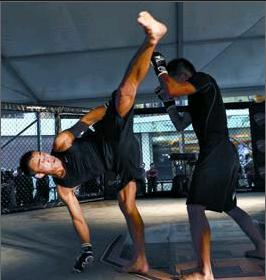Martial Arts Adapt
2014-03-11ByJosephhalvorson
By+Joseph+halvorson

On a recent subway commute in Beijing a man who appeared to be in his 60s sat transfixed by a clip from a martial arts movie playing on one of the television screens normally reserved for public safety announcements and flamboyant Pepsi commercials. His body jerked suddenly as he threw a short uppercut in synch with the fighters before pulling back to resume the placid posture of a morning commuter.
Down the row of seats, others had taken a rare glimpse away from their smart phone games to watch the same action unfolding on the small LCD screens. Unlike the sprawling outdoor kungfu scenes now familiar to Chinese audiences, the clip featured two men competing inside a locked octagonal cage, using a variety of both strikes and ground techniques in a sport known as MMA, or mixed martial arts.
The puzzled expression of the subway passengers suggested something many of us in the world of competitive martial arts already knew: MMA is largely unknown in China, despite a long history in the traditional martial arts.
At the Yekoan Muay Thai boxing club inside central Beijings Ritan International Hotel, I see Chinese men following a path of martial arts similar to the one I took a decade ago in the United States, when I was in my teens. With backgrounds in kungfu or sanda (a competitive fighting style that incorporates striking and throwing techniques), these fighters have sought to internationalize their combat repertoire. The head Thai boxing coach is a former professional kickboxer from Thailand with over 450 fights on his record. With a sparse English vocabulary and almost no Mandarin to speak of, he communicates with students using body language—sometimes getting a difficult point across with a swift kick to the midsection, or a sudden sweep to the padded mat.
What makes MMA so unique is that it brings together a variety of competing disciplines from all over the world—jiu-jitsu from Japan, wrestling and boxing from the United States, kickboxing from Thailand, Taekwondo from Korea and kungfu from China—and pits them against each other in such a way that only the most practical and effective techniques survive, adapt, and merge, while the more flashy and impractical forms of the traditional martial arts are abandoned.
The United States-based Ultimate Fighting Championship (UFC) made its first foray into Chinas mainland in 2014 with its reality show, The Ultimate Fighter. I went to observe the tryouts held last year, where over 150 fighters from all over the country gathered to compete for 16 spots in the featherweight and welterweight divisions. Those chosen were flown to Liaoning to live together for six weeks in a houseendprint
where their training sessions and daily lives were filmed, with each episode culminating in a fight to determine who would be eliminated and who would advance to the next round.
With the filming wrapped up and the season finale scheduled to air live on March 1 in Macao, the show has been a minor success in China, although some questioned the level of talent after it was revealed that one of the competitors was a yoga instructor with no professional fighting experience.
When I hear about small MMA shows in China I notice a spooky resemblance to the sports early days in the United States, before it went mainstream circa 2004: crooked promoters are known to match their rising stars against amateurs with little or no skill; broken promises regarding payment leave struggling fighters with barely enough to survive until their next bout; and dangerous conditions with inadequate ringside medical supervision make injuries commonplace. This Wild West stage of evolution is a familiar hurdle that regulators and promoters must overcome in order to make MMA a viable sport for the countrys athletes.
Despite its limited popularity in China, the origin of MMA arguably began with one of its own: Li Xiaolong, better known to Western audiences as Bruce Lee. By studying an array of fighting forms rather than stubbornly sticking to one “superior” style, he was able to become a well-rounded martial artist whose innovative approach to fighting inspired generations of practitioners. His philosophy of martial arts, heavily influenced by Taoist thought, still resonates today: “Adapt what is useful, reject what is useless, and add what is specifically your own.”
As China seeks to navigate the global cultural landscape in a way that emphasizes its unique advantages, the message of adaptation is a useful one. Whether it is a Chinese fighter stepping into a cage for the first time or an artist of a less violent—and more “harmonious”—pursuit, we can all benefit by engaging with a multitude of perspectives, styles and techniques. May the most adaptable win.endprint
